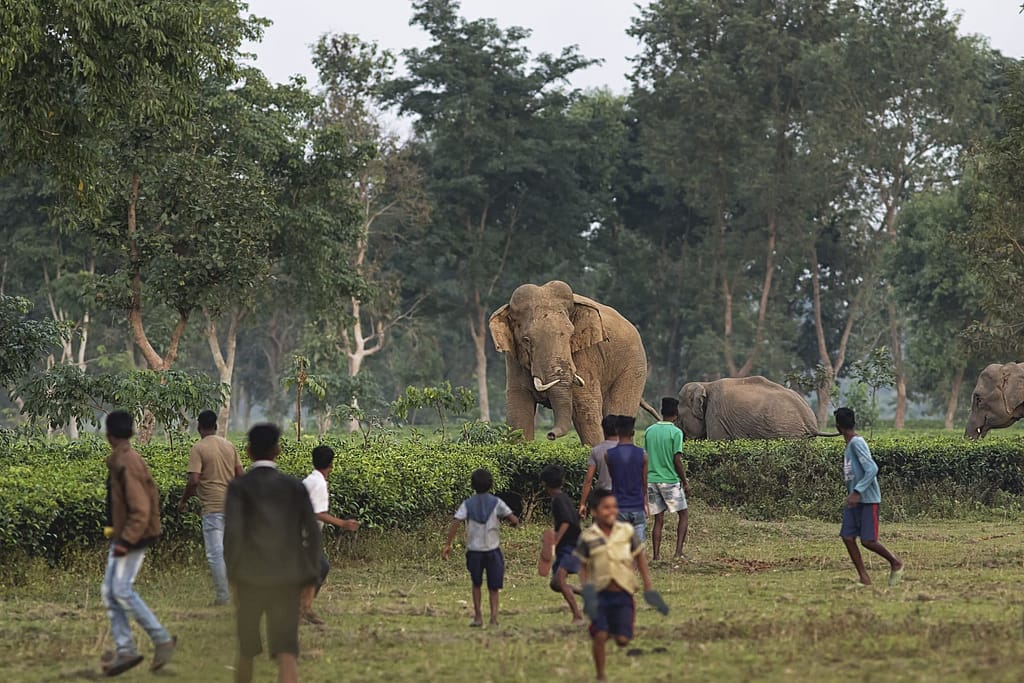
About where the forest roars: Midnight on the India-Nepal border. A full moon hides behind the clouds, no longer illuminating the wisp thin trail. The snow peaks of the eastern Himalayas are shrouded in darkness. A crowd forms along the edge of a field: farmers with flashlights, boys with firecrackers and mobile phones, and young men with homemade cannons firing loud bombs that arc sparks of orange against the sky. Across the open farmland, from several locations, searchlights sweep from clusters of homes and surrounding dirt paths while the forest roar. Aggressive shouting, static from walkie talkies, and continuous bursts of crackers echo like a game of call and response. I think of the front lines of war zones.
Intermittent sirens blast from the loudspeaker of a patrol jeep, headlights flashing. A farmer shines a broad beam of light out over his crops. Less than a stone’s throw from where we stand, an Asian elephant, with sharp tusks and the sticky black secretion of musth visibly draining from his right temple, slowly chews the rice paddy. The tusker does not appear ruffled in the least by the cacophony that surrounds him. I am transfixed. The man next to me lights, raises and shoots a cannon—the blast sounds lethal, but isn’t. Unexpectantly, silence follows. All shouts and firecrackers, even the sirens abate where the forest roars. The tusker, known by the name Lama, continues to eat. Out from the trees across the field rises a noise I have only heard in movies and dreams: the resounding trumpet of an elephant. From a patch of trees directly to our right, another elephant responds with an earth-shaking full bellow roar, accompanied by a steady and thunderous rumble that rattles me to my core.
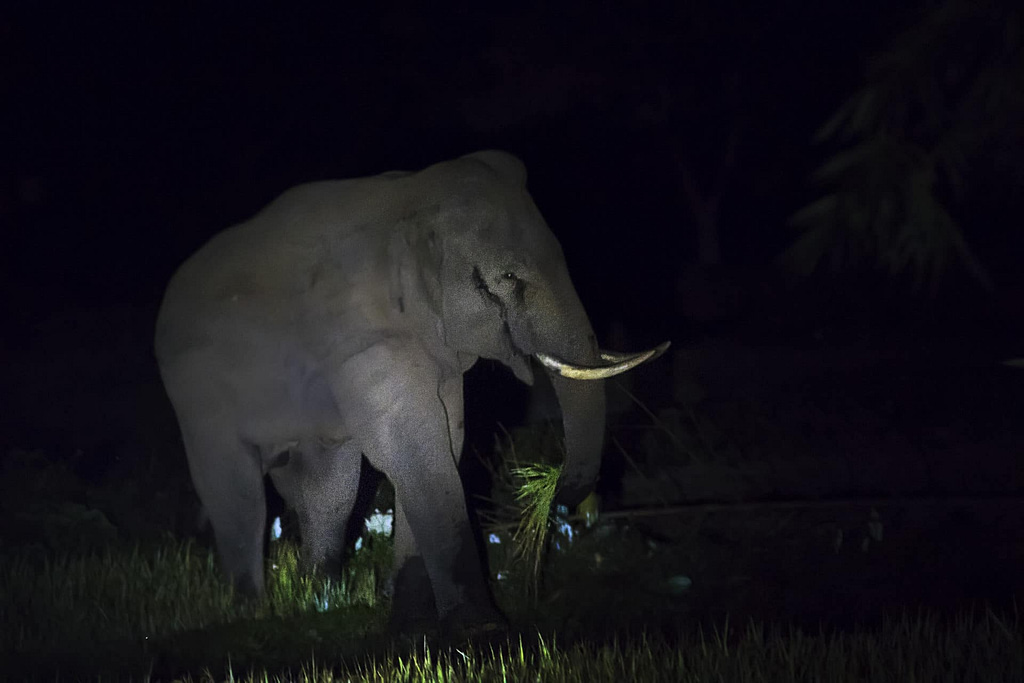
This moment is why I have returned to North Bengal after three journeys in two years. What began as a desire to tell a single story about wild elephants and selfie deaths has become a quest to deeply understand human-elephant co-existence in this region of India.
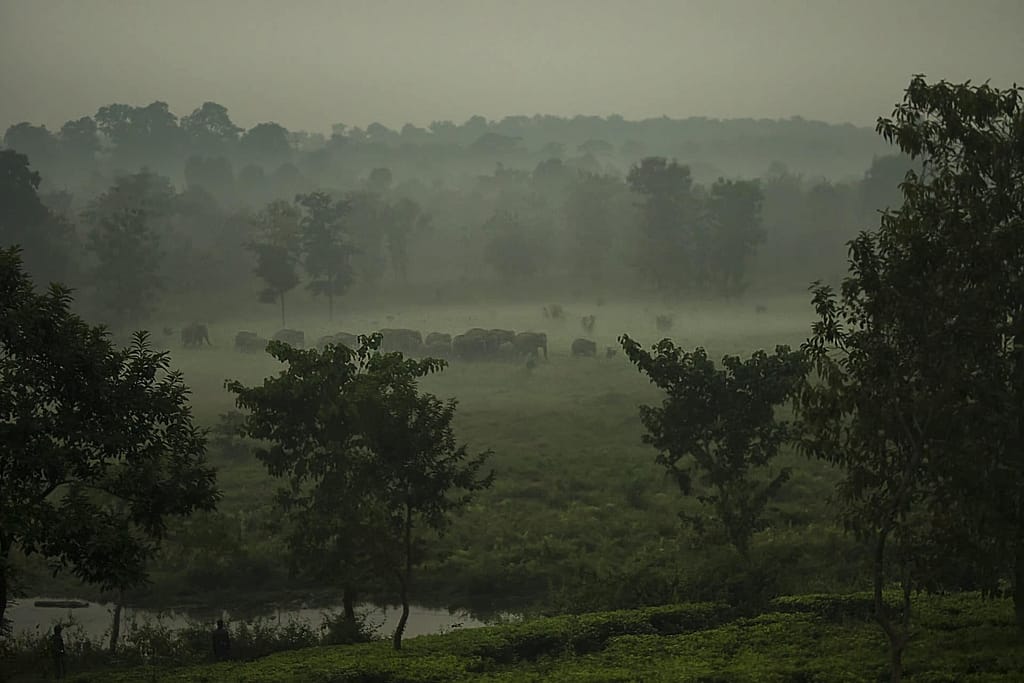
Many misperceptions exist about elephants in India. Elephants here are veering toward extinction at unprecedented rates, more quickly, and for different reasons, than their African cousins. The most critical threat to these elephants is loss of habitat, not poaching (though it is an issue), because only male Asian elephants have tusks, and not all of them. Unlike elephants in Africa, Asian elephants have co-existed with humans sharing the same landscapes, resources, and also as “domesticated” working partners, for over 4,000 years. In India, elephants are traditionally revered as gods, and killing an elephant has carried a stiff penalty since Emperor Ashoka created the first wildlife conservation act in 300 BC.
More about where the forests roar
Once supporting wildlife and people in delicate balance, this ancient habitat stretches along the foothills of the Himalaya from Bhutan to northern India and onward through Nepal. Rapid population increase and widespread deforestation have turned the former lush migratory routes for Asian elephants into a dangerously fragmented landscape. Elephants now struggle to survive by travelling between patches of natural forest interrupted by barbed fences, swaths of tea gardens, chaotic highways, unpredictable and speeding trains, and numerous villages with paddy crops ripe for harvest. Desperate for food, elephants have discovered that these crops deliver far more nutrients, in much shorter time, than anything they are currently able to glean from the stripped forests. The diminishing lack of natural resources is a root cause in the human-elephant conflict, resulting in the fatal clashes that kill over 400 people and 100 elephants each year.
I am here throughout this night, prepared to run if necessary, determined to experience the fever pitch of the conflict first-hand with my guide and friend, photographer/local elephant expert, Avijan Saha. Avijan has been identifying bull elephants, documenting the herds, and building relationships with people in this intense conflict zone for years. He is a key communication hub between communities, tea garden owners, Forest Department officials, and local NGOs— if there is an incident, Avijan gets the call. We are joined by local administrator, Tufan Mallick, his brother, Kishore Pradhan, a social worker and farmer. Both men have had their property destroyed by elephants and many close calls. They are well- respected in this area and with us tonight to provide protection, as I am the only woman (and foreigner) in this nightly foray.
While the forest roars, Lama lifts his head and slowly makes his way into the trees. The smell of musth, earthy and ominous, clings to the mist and smoke that swirls around us. Elephants in musth tend to be violent, attacking when disturbed while the forest roars. Even calves in herds are vulnerable to their deathly aggression. The hormone secretion during this period has approximately 60 times more testosterone than a typical male elephant. With two teenage daughters and a loving husband waiting for me at home, I am loathed to move closer. Risk is sometimes difficult to fully calculate until you are in the thick of it, leaving little to do but manage. My companions see this situation differently and soon we are following Lama’s route.
Not wanting to take a chance, I wait alone near a fragile tin house glowing with purple lights to make it visible to passing traffic. Avijan instructs me to throw myself inside the crack between the house and the outbuilding should an elephant appear. The crowd from the field—mostly young boys seeking entertainment – joins our team, forming a reception line at the bend of the highway where the tusker is expected to cross. Hours earlier, I watched a herd of ten mothers and calves peacefully pass through this exact spot while our companions stopped traffic so they would be safe from the nighttime truck caravans. Avijan tells me the elephants are so intelligent that they always cross at this particular bend so headlights from oncoming vehicles have a greater chance of seeing them.
I am still wearing my motorcycle helmet, as we are continuously moving for several kilometers over dark rocky trails and there is never time to secure it between each transition while the forest roar. My daughter painted an intricate third eye on the front and a spectacular Ganesha across the top. In my mounting fear, wearing this helmet gives me a sense of spiritual and physical protection. The crowd grows larger. I think them foolhardy and I am stricken for putting myself at such risk. Momentarily distracted by a phone alert from my daughter’s dermatologist, I text an urgent appointment reminder to my family back home. When I look up, the mob running towards me, flashlights waving across the field. While I was distracted, Lama has fooled the others by passing directly behind me. Hundreds of people are killed by elephants each year, by taunting and daring, taking selfies, or simply by being in the wrong place at the wrong time. That I was spared by an agitated elephant, whose hormonal situation predisposes him to violence, makes me believe that somehow he knows why I am here; that he granted me forgiveness and let me be.
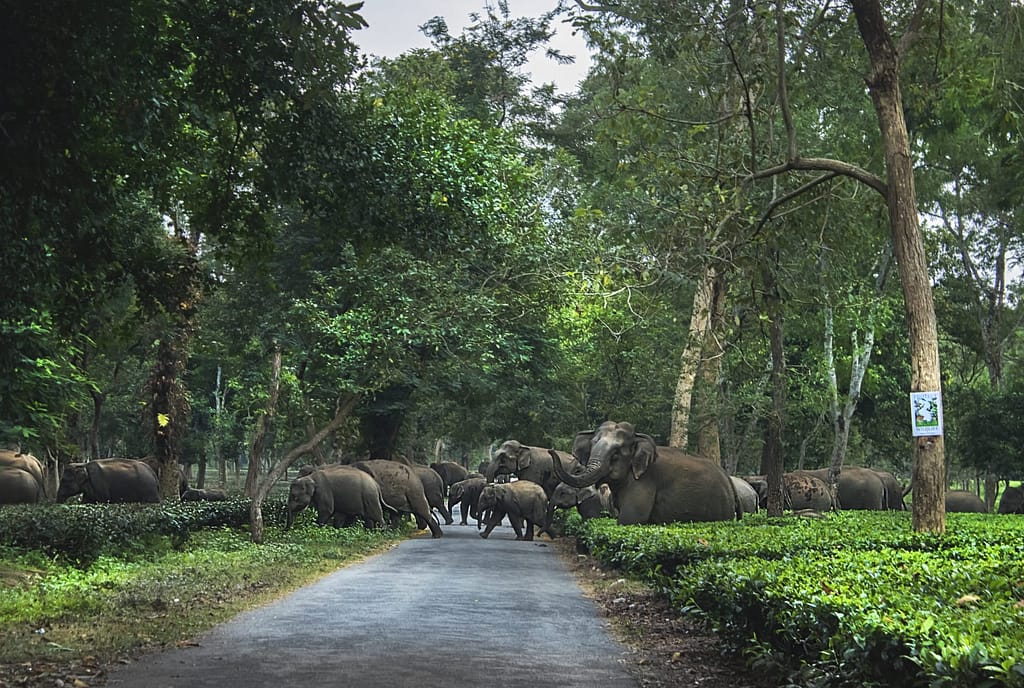
Bearing witness has its limits and mine passed hours ago with the first herd sighting. An overpowering sense of shame and complicity as I silently stood among men shouting and chasing, making me wish to never disturb a wild elephant again. But how could I run home to a soft bed in a protected place when the farmers I stand with will keep vigil all night, using only a flashlight and sound makers to protect their crops, their wives and children in uneasy sleep, fearful their homes will be crushed in the wee hours, and then work the fields all the next day? The families in this community, and hundreds like it throughout India, are living with this threat and tension every night during each crop cultivation season. Meanwhile, matriarch elephants struggle to feed and protect their calves and herd, meeting terrible deaths by train strikes, electrocution from illegal fencing, and falling into trenches dug to keep them out of tea gardens. So many barriers to their movement, with virtually no protected space to move and eat.

“Daytime is for humans,” Avijan explains, “The night belongs to wildlife.” While humans originally created this crisis, these particular humans inherited it. It is easy for those of us who live in solid houses, with reliable access to life’s pleasantries, to insist on the protection of elephants. It is entirely different to live with daily threat and still embrace the elephant as a deity; to accept that if the elephants die, we perish too. Remarkably, that sentiment still exists, even among those who have lost family members while forest roars. But patience is wearing thin on both sides.
A man was killed here by a bull a few nights before while the forest roarw. The tusker had not only trampled him but ripped apart his body. The incident occurred around 5:30 am during an outdoor bathroom break—common in communities with no indoor plumbing. Avijan was understandably shaken: “This level of aggression is rare; it appears to be a vengeance kill.” There is mounting anger, particularly among bull elephants and young male humans. So much taunting, running straight at the herds and screaming, sometimes throwing rocks. The elephants always quietly walk away—their peaceful nature a stark contrast to this human ugliness. The bull elephants are less predictable—typically on their own, outside of the mostly female herds, they wreak havoc, crushing people and homes in search of food, even stored rice beer.
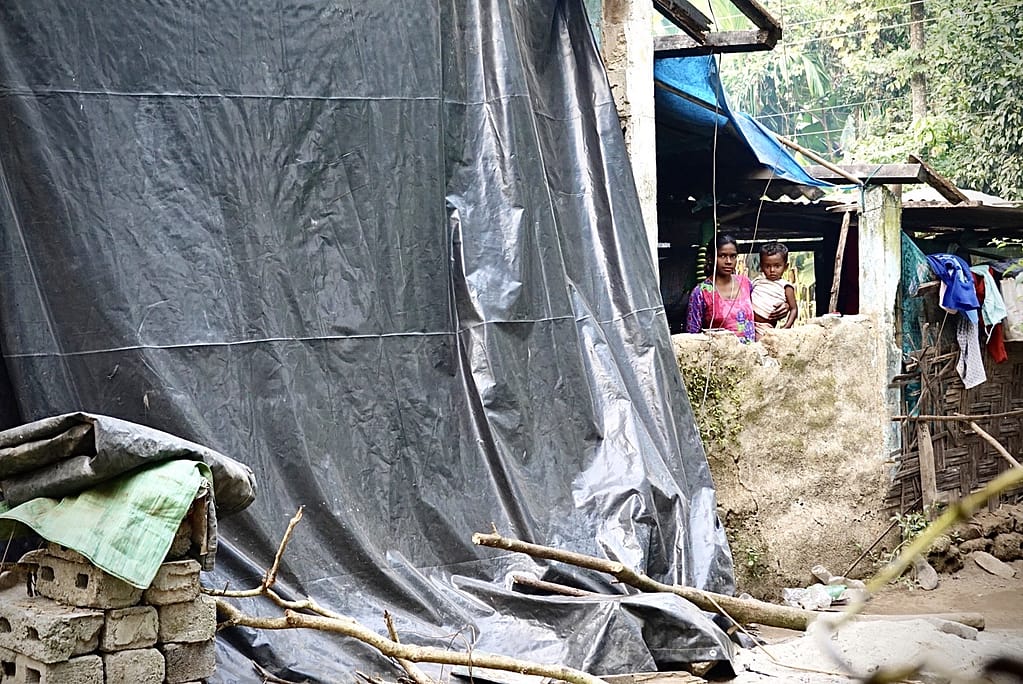
The elephants now rely on crops for their highest, most efficient nutrition, and their habits are adapting as they shift their diets to survive. North Bengal serves as a warning — resources are so depleted that there is now a war for the scant remainders. Yet, the elephants seem to be taking the higher ground.
A local Forest Department officer told me a story from a few mornings before. He received a call that an elephant had destroyed a hut in a nearby village. When he arrived on site, the entire village was gathered in silence, circling a young girl who was miraculously uninjured. The bull elephant had entered the house early in the morning to raid a storage of rice beer in a back room. The child’s parents had escaped, but their daughter was trapped. The elephant scooped up the girl with his trunk and gently set her down outside, out of harm’s way. Returning to the house, the bull continued to rampage for food, crushing most of the structure before heading off into the forest.
Even in the midst of mounting fear and anger, efforts are underway to help protect both elephants and farmers and find common ground. The situation for elephants throughout India is dire, but so many entities and individuals are working literally day and night to help fix the complicated crisis. NGOs such as Wildlife Trust of India have identified 101 zones where the elephants’ natural movement between patches of forest is being blocked. They have engaged a wide network of local volunteers and NGOs to serve as Green Corridor Champions, working with tea gardens such as Sonia Jabbar, inspiring owner of Nuxabara Tea Estate to create safe passages, conduct awareness raising campaigns for villagers, and supply tools to help people better co-exist with the wildlife at their front door. Innovative solutions, such as alternative fencing, crop insurance or banks, new laws for train speed and signals, and research to track elephant movement and habits are all underway in the effort to decrease the conflict and create a healthy coexistence.
The people in this region have become my friends; their work is an inspiration while exploring where the forest roars. This urgent crisis and the lessons within have taken root, motivating me to share these complex stories with compassion and honesty. We tend to read a headline and make an assumption, see a photo and make a judgement. We are quick to campaign for or against things we know little about. Often, we accept a singular view, depriving us of the opportunity to understand truth in the appropriate cultural and historical context. This has become my driving force.
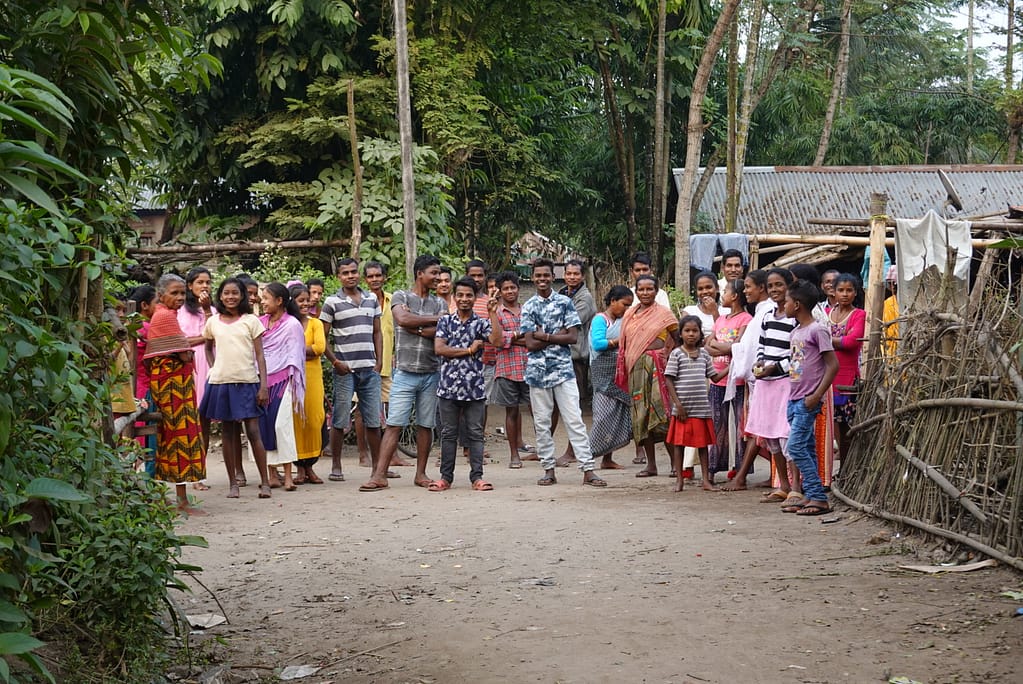
There is hope. But the entities who are responding to the crisis: the wide array of government officials who have traditionally been at odds with one another, local communities, advocacy groups, media, business owners, and international funders must work harmoniously in unprecedented ways. Given the urgency, many are rising to the occasion. No one is sleeping. The Forest Department personnel are in tears when they recount stories of the crowds harassing herds, the elephants in fear and pain, the mystical elephant stories that seem unbelievable, yet they are recounted from their own experience. All speak from this certain knowledge of elephant wisdom. Those who know, believe the elephants are trying to communicate, that they understand beyond our limited comprehension. Every person I spoke to believes this with their heart and soul. For coexistence to work, basic needs must be restored through meaningful solutions ensuring food, shelter, and safety. There is still time. The elephants are trying to teach us something; it is up to us to listen and act.
Moments while the forests roars
It is 2:30 am and at last, we are headed back to the house. As we approach the fragile structure, we startle another bull elephant eating from a tree in a neighbor’s yard. He turns to face us and I am certain he will charge. Tufan’s brother, whose wife and children are asleep next door, and whose house and crops have already been damaged by elephants, rushes the bull to chase him off. The elephant begins to slowly walk away with astonishing calm. The neighbors come out from houses. While the others ensure the elephant is far afield, I am taken to the house I was once so eager to return to, only now realizing that there is no safety here.
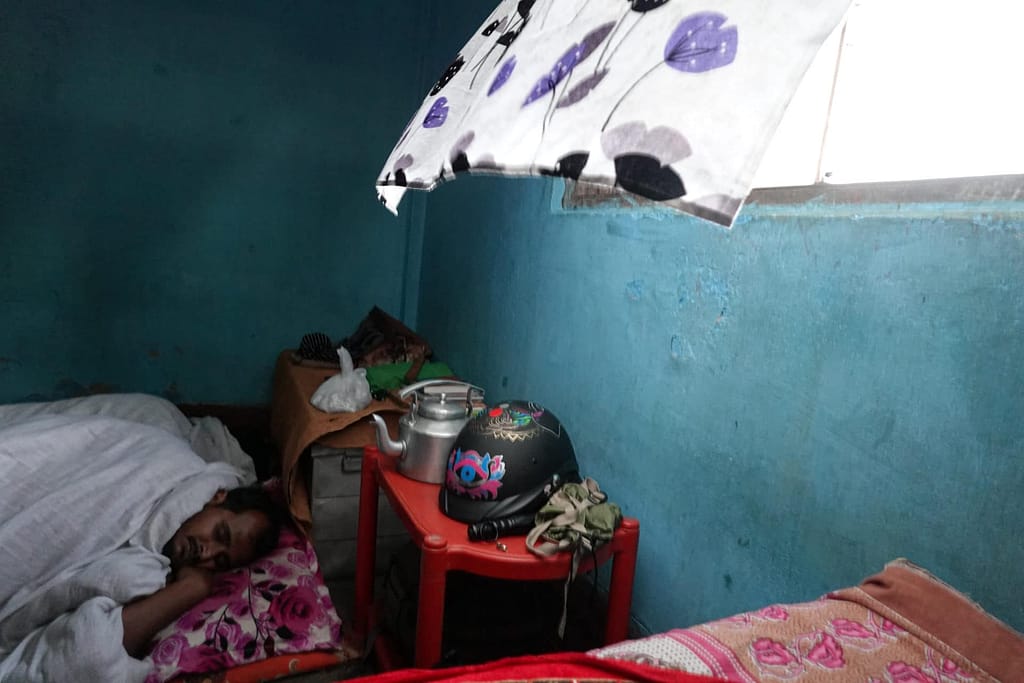
My sleep is filled with a kaleidoscope of dreams: yelling boys chasing slow sauntering herds, thick black oozing from the eye of the tusker, sirens, flashing lights, explosions, angry trumpeting. I wake to a strong sense of foreboding certain the elephant from last night is roaming nearby. This is the hour when people are killed, as they venture out in half sleep to relieve themselves or gather wood for the breakfast fire. In stillness, with full bladder, I wait, my male companions snoring on the floor below me. When the light becomes more pronounced, I peer out. Framed directly through the window, etched in white against a milky blue sky, is Kanchenjunga, the highest mountain in India, third highest in the world. To the left of it, Everest. All these days, I was within full embrace of this range, but only now does it appear. Before me stands proof that just because we can’t see something doesn’t mean it isn’t there … or it isn’t true. The moment is holy. My helmet lies on the bedside table beside me, a talisman. The weight of my new sense of responsibility feels crushing, even now.
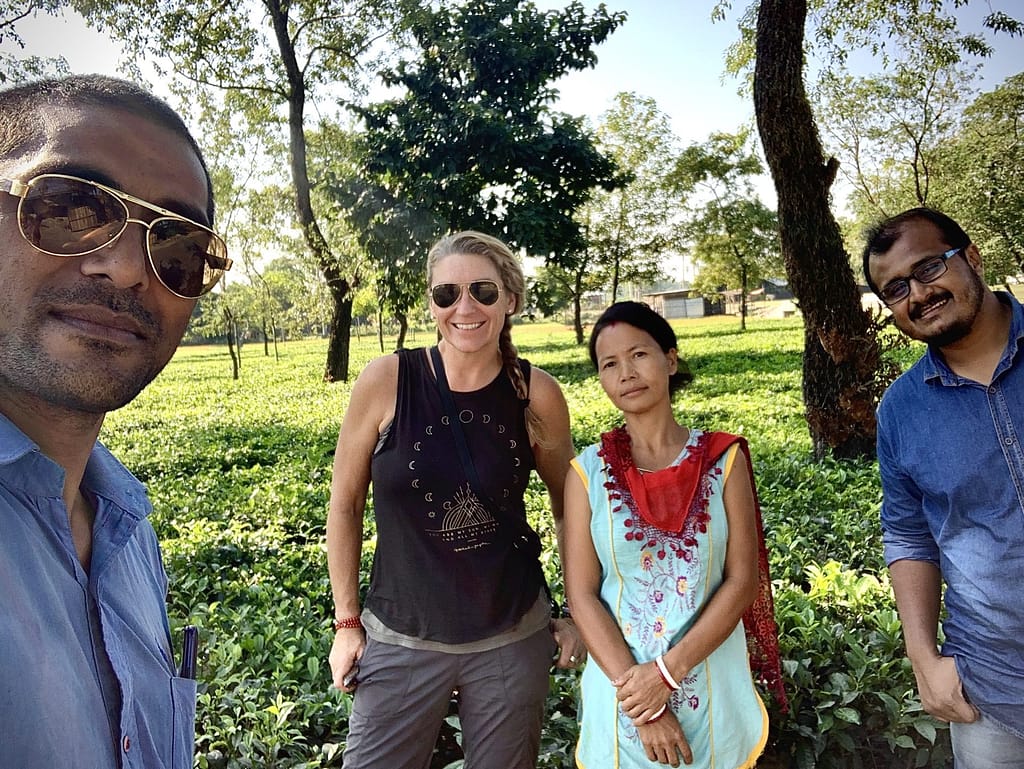
Read the original story as published in Sidetracked Magazine.








































